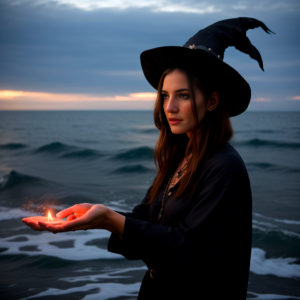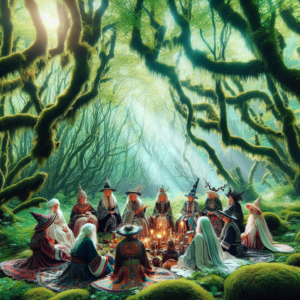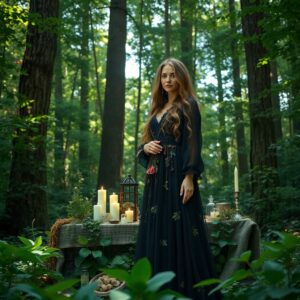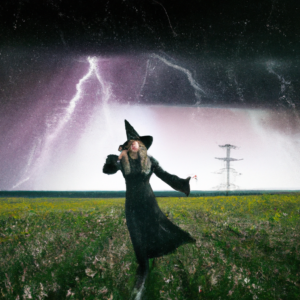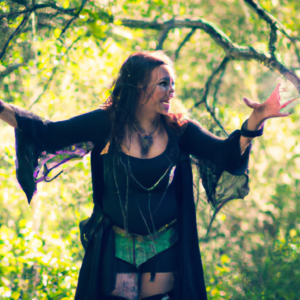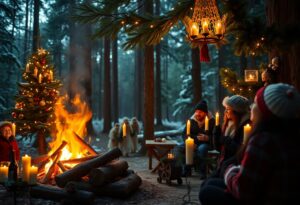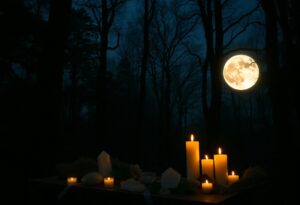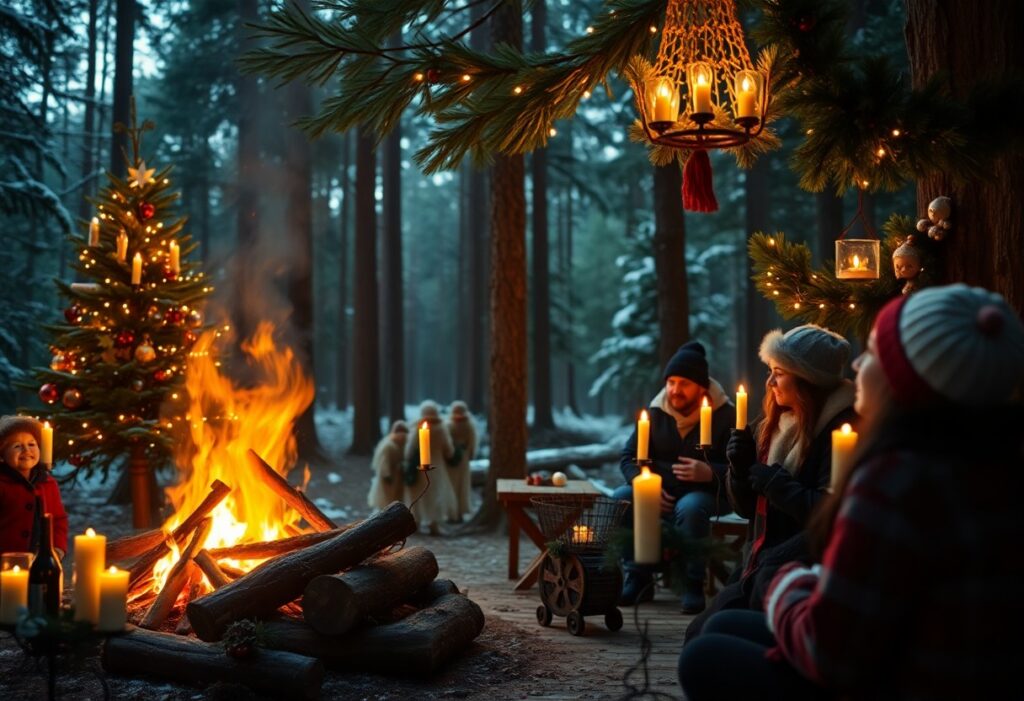
There’s a rich tapestry of traditions and beliefs surrounding Yule, an ancient festival celebrated by Pagans during the winter solstice. This time marks the rebirth of the sun and is deeply rooted in seasonal changes and agricultural cycles. As you explore the history of Yule, you’ll discover how various cultures infuse their unique customs and rituals into this vibrant celebration, fostering a deep connection to nature and community. Understanding these practices can enhance your appreciation of Yule and what it symbolizes in the modern Pagan spiritual landscape.
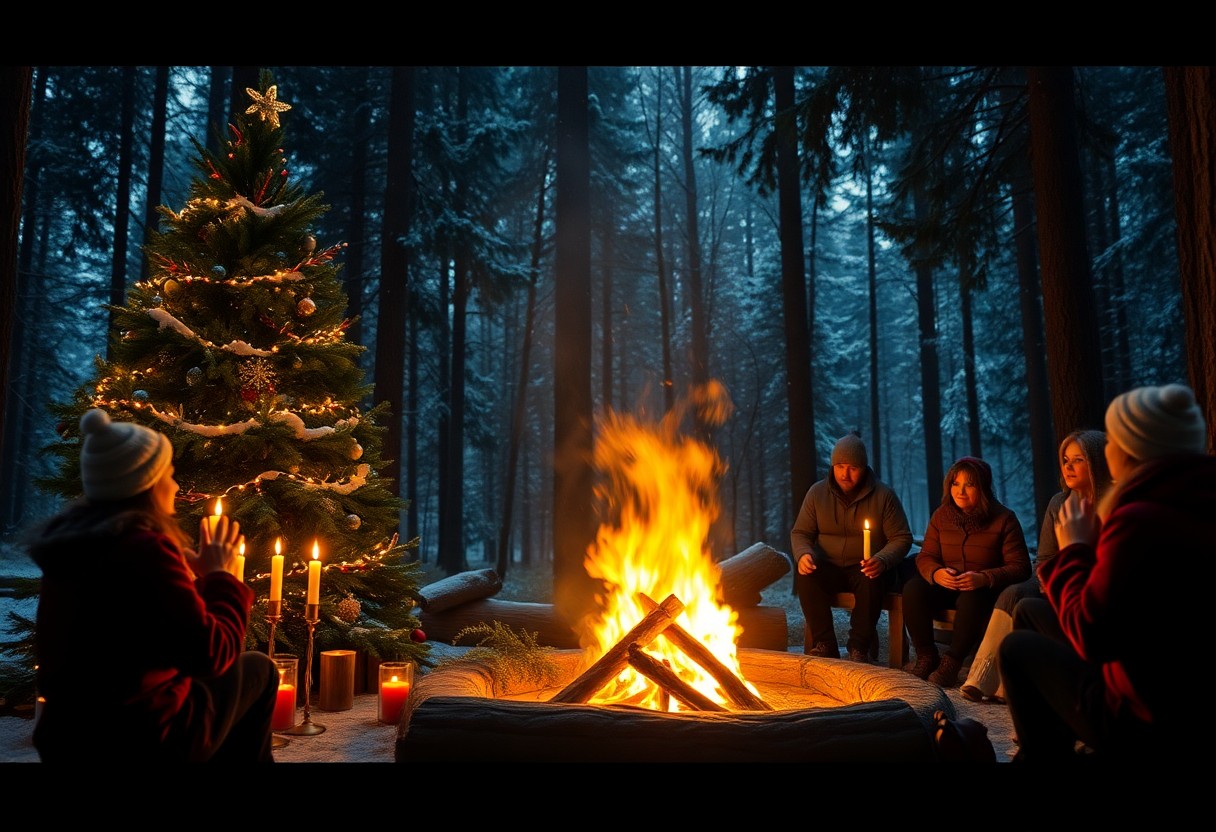
Key Takeaways:
- Winter Solstice: Yule coincides with the winter solstice, marking the longest night of the year, symbolizing the rebirth of the sun and the return of light.
- Nature and Cycles: Pagans celebrate the cyclical nature of life and the earth’s seasons, honoring the balance between darkness and light.
- Community and Tradition: Yule includes various rituals and festivities that strengthen community bonds and connect participants to ancestral traditions and nature.
The Historical Roots of Yule
Ancient Origins of Yule
Origins of Yule trace back to ancient times, where it was celebrated by various cultures as a festival marking the winter season. The earliest records indicate that the festival is strongly linked to the Germanic tribes, who honored the rebirth of the sun during the long, dark winter months. This was a time for communal gatherings, feasting, and rituals aimed at welcoming the return of warmth and light. The celebration often included the burning of a yule log, symbolizing the sun’s return and the promise of new life in spring.
As the centuries progressed, Yule began to incorporate elements from various pagan traditions throughout Europe. Each culture added unique practices and meanings to the celebrations. From the Norsemen’s celebration of the winter solstice, known as “Jól,” to the Celtic traditions of celebrating the rebirth of the Oak King, Yule became a rich tapestry of beliefs and practices that shared a common respect for nature’s cycles and the transition between seasons.
Yule and the Winter Solstice
Across different cultures, Yule is deeply intertwined with the winter solstice, the shortest day of the year, which typically falls around December 21st. This astronomical event has been marked by various civilizations for millennia, as it represents a turning point in the natural world—a moment when darkness begins to recede and daylight slowly returns. You might find it fascinating that many pagan customs associated with Yule align with this celestial phenomenon, emphasizing themes of hope, renewal, and the enduring circle of life.
Solstice celebrations served to reinforce the importance of light in a world that had darkened. Many rituals were performed to honor the sun’s return, such as lighting candles or fires, which symbolized not only warmth but also the light that would gradually increase with each passing day. Participating in these ceremonies can provide a deeper connection to the rhythms of nature and remind you of the strength found in cycles of darkness and light.
Cultural Significance in Pagan Traditions
Against this backdrop of ancient significance, Yule occupies an important place in various pagan traditions today. It is seen not only as a celebration of the winter solstice but also as a time of reflection and renewal in your own life. Many modern pagans focus on the themes of transformation and the reawakening of nature during this season. Yule serves as a reminder to embrace the darkness as a necessary part of growth and change, much like the earth recharges before bursting forth with life in spring.
For instance, you may find that many contemporary rituals include the decoration of Yule trees, sharing of solemn feasts, and the creation of altars adorned with natural elements such as evergreen boughs and crystals. These practices reinforce a connection to the Earth and your own personal journey, allowing for introspection and intention-setting as the year comes to a close. Engaging with these traditions can enrich your experience of Yule, inviting you to honor not only the historical roots of the festival but also your own path within its legacy.

The Spiritual Meaning of Yule
You might be surprised to learn that Yule is rich with spiritual significance and profound symbolism. This ancient festival, celebrated by Pagans around the time of the winter solstice, marks a pivotal point in the yearly cycle. As the longest night of the year unfolds, it invites reflection upon the nature of darkness and light. You engage with this duality through various rituals and celebrations that not only acknowledge the turning of the wheel of the year but also offer an opportunity for personal transformation and spiritual growth.
Symbolism of the Winter Solstice
An crucial aspect of Yule’s spiritual meaning lies in its association with the winter solstice. This solstice symbolizes the rebirth of the sun, as the days will slowly begin to lengthen following this climactic moment. For you, it represents the transition from dormancy to vibrancy, where the darkness is a natural part of the cycle that allows for rest and introspection. The yule log, a centerpiece in many celebrations, embodies warmth, light, and the hope for renewal as it burns, signifying the struggle against the cold and dark.
Themes of Rebirth and Renewal
Between the ancient traditions and modern interpretations, the themes of rebirth and renewal resonate deeply during Yule. It’s a time for you to consider your own life cycles—what aspects may need to be released, what new projects or ideas might be nurtured, and how you can embrace change. This festival encourages you to plant seeds of intention for the coming year, recognizing that after the retreat into darkness, new growth is on the horizon. The symbolism of rebirth extends beyond nature, urging you to reflect on your own personal growth and transformation.
Renewal is not merely a theme; it is a powerful invitation for you to embrace potential and change. The idea that after every bleak winter, spring will inevitably come symbolizes hope and transformation in your own life. Embracing this renewal can manifest in various ways, from setting intentions to purifying your space, and even crafting rituals that honor the new beginnings you desire. Yule encourages you to celebrate the light returning and what that means for your journey ahead, cultivating optimism as you move forward.
Connection to Nature and the Earth
On a deeper level, Yule is a celebration of your connection to nature and the earth. As a Pagan, you recognize that the earth follows cycles that govern life, and the winter solstice is a powerful reminder of the interplay between growth and decay. This connection is not just ecological; it symbolizes your place within the natural world and the rhythms that influence your existence. Yule rituals often include honoring the spirits of nature, reinforcing the bond between you and the elements that sustain your life.
Connection to nature during Yule can be expressed through various practices, such as decorating your home with evergreen branches, lighting candles to symbolize the sun’s return, and engaging in outdoor rituals. These acts invite you to ground yourself in the natural world and reflect on the changing seasons, allowing you to cultivate gratitude for the resources and beauty that surround you. By honoring this connection, you deepen your understanding of the cycles of life and your role within them, fostering a sense of harmony and balance.
Yule Traditions Across Different Cultures
Not all cultural traditions are the same when it comes to celebrating Yule. Each heritage offers unique practices that reflect their values and beliefs, making Yule a diverse and fascinating celebration. In particular, understanding the Germanic and Norse influences on Yule can enhance your appreciation for the deeper meanings behind this ancient festival.
Germanic and Norse Influences
Any discussion of Yule undoubtedly brings to mind the rich heritage of the Germanic and Norse peoples. These traditions highlight the importance of the Winter Solstice and the rebirth of the sun. In Norse mythology, the festival was known as “Jól,” a time filled with feasting, lighting bonfires, and performing rituals to ensure fertility and good fortune for the year ahead. You may find that many modern Yule practices, such as the Yule log and the use of evergreens, are derived from these ancient customs.
Moreover, Germanic tribes celebrated Yule with similar fervor, emphasizing family gatherings and communal festivities. The act of feasting and sharing stories around a fire fostered connections among the tribe while paying homage to deities associated with the winter season. You can appreciate how these rituals reflect the need for unity and resilience during the darkest days of the year.
Celtic Traditions and Celebrations
Different from their Germanic counterparts, Celtic traditions associated with Yule were often steeped in nature and the changing seasons. Known as “Midwinter,” this celebration was a time for honoring the Earth and acknowledging the returning light. You might be intrigued to learn about the significance of holly and mistletoe in Celtic customs, both of which symbolize protection and renewal as the year inches closer to spring.
Hence, you can view the Yule traditions of the Celts as a celebration of nature’s cycles. Customs such as lighting candles in windows to guide the sun back and the practice of feasting with loved ones reflect a deep reverence for the interconnectedness of all life. The stories they shared during Yule served to bond communities while passing down important knowledge and wisdom through generations.
Influence of Christianity on Yule Practices
Celebrations of Yule did not remain isolated from the tide of Christianity that swept across Europe. As Christian missionaries worked to convert pagan populations, they often blended the existing traditions of Yule with Christian beliefs. This syncretism created unique celebrations that still honored the joyous aspects of the solstice while introducing themes aligned with Christian teachings. You might be surprised to see how many customs we associate with Christmas today can trace their origins back to Yule practices, such as decorating with holly and exchanging gifts.
Furthermore, it’s vital to note that many ancient practices did not vanish but instead transformed. Norse and Celtic Yule elements often converted into Christmas traditions, exemplifying how cultural exchanges can shape celebrations. You’ll find that observances such as the Yule log and the spirit of giving resonate in both Yule and Christmas, creating a delightful tapestry of shared heritage and continuity.
Norse mythology continues to influence the way we celebrate Yule, even in contemporary contexts. The belief in the return of the light symbolizes hope and renewal, resonating well beyond its pagan roots into a broader cultural narrative. Understanding this shared history around Yule can inform your own celebrations, giving you a meaningful connection to the past and a joyful outlook on the coming year.
Yule Celebrations and Rituals
Your experience of Yule can be deeply enriched by embracing various traditional celebrations and rituals that honor this time of year. These practices, rooted in ancient customs, not only serve as a connection to your Pagan ancestors but also help you reflect on the themes of rebirth and renewal that Yule embodies. From lighting the Yule log to community gatherings filled with feasting and festivities, each aspect of the celebration carries profound meaning and a sense of belonging within your community.
Lighting the Yule Log
For many Pagans, lighting the Yule log is one of the most cherished rituals of the season. Traditionally, the Yule log is a large piece of wood that is adorned with seasonal greenery and decorated with symbols of prosperity and protection. As you prepare to light the log, consider the intentions you want to set for the coming year, inviting warmth and positivity into your home. The log is usually set ablaze on the longest night of the year, symbolizing the return of the sun and the gradual lengthening of days, inspiring hope and renewal.
For some, this ritual may extend over several days, with pieces of the log added incrementally to the fire, often accompanied by family traditions or offerings to the spirits of nature. The act of kindling the fire itself can evoke feelings of unity, as you gather with loved ones, sharing stories and expressing gratitude for the past year while looking forward to what lies ahead.
Decor and Symbolic Elements
With Yule comes a rich tapestry of decor and symbolic elements that serve to enhance your celebrations. Evergreen plants like holly, mistletoe, and fir play a key role in Yule decorations, symbolizing everlasting life and resilience against the harshness of winter. You may also find candles prominently displayed, representing the light returning to the world and the enduring presence of the divine within. Each decor element carries its own significance, inviting you to imbue your home with intention and meaning.
But the power of Yule decor lies not just in aesthetics; these symbols are reminders of nature’s cycles and the interconnectedness of life. The use of red and green in decorations reflects fertility, transformation, and the life force present within nature during this restful season. As you adorn your space, consider how each item in your home resonates with your personal beliefs and the broader narrative of Yule.
Seasonal Feasting and Community Gathering
About the essence of Yule lies in the communal experiences centered around seasonal feasting and gathering. Food is a powerful tool for connection and celebration, and during Yule, it serves as a way to honor the bounty of nature and express gratitude. Traditional Yule feasts often consist of hearty meals featuring seasonal ingredients, highlighting the importance of sharing abundance with your community and loved ones. Sharing food not only nurtures the body but also strengthens bonds, creating lasting memories and fostering a sense of belonging.
Even outside the dining table, community gatherings during Yule typically include storytelling, singing, and various forms of entertainment that highlight cultural traditions. This shared experience of coming together in celebration creates a tapestry of connection and joy that enriches your Yule celebration, reminding you of the strength found in unity and the warmth of shared experiences during the coldest months of the year.
Yule in Modern Pagan Practices
All over the world, modern Pagans celebrate Yule as a significant point in their spiritual calendar. This holiday, marking the winter solstice, is a time for reflection, renewed energy, and the celebration of light returning to the world. Many practitioners gather to honor the cycles of nature and the rebirth of the sun, creating a space for community and individual connection to the Earth’s rhythms. With its rich history and diverse cultural practices, Yule in contemporary Paganism invites you to explore your own spiritual beliefs while partaking in ancient traditions.
Eclectic Paganism and Yule
Any practitioner of eclectic Paganism will find Yule an exciting opportunity to blend various traditions and personal beliefs into your celebrations. This approach allows you to incorporate elements from different cultures or spiritual paths, creating a Yule celebration that reflects your unique perspective. You might draw from Norse practices, Celtic traditions, or even incorporate modern adaptations, such as creating rituals that focus on community service and environmental stewardship.
As you adapt Yule traditions to fit your eclectic practices, consider what resonates most deeply with you. You could include a ceremonial feast, decorate with evergreen branches symbolizing life and continuity, or even create your own rituals that reflect your individual beliefs. This flexibility allows your Yule celebrations to evolve each year as your spiritual journey continues to grow.
Wiccan Traditions Around Yule
Below is a deeper exploration of how Wiccan traditions center around Yule, marking it not only as the winter solstice but also as the rebirth of the God. In Wicca, Yule is a time of both reflection and festivity, honoring the return of the sun after the longest night of the year. Rituals can include lighting candles or a Yule log to symbolize warmth and light returning to the world. You might also perform a circle ceremony, calling upon the elements and deities that hold significance for you during this time.
With the celebration of Yule, Wiccans often engage in rituals that symbolize rebirth and renewal. Many create altars adorned with seasonal symbols like holly, ivy, and mistletoe, utilizing these natural elements to invoke the energy of the Earth as it rests in winter’s embrace. You may also find joy in exchanging gifts or sharing a communal meal, mirroring ancient traditions that remind you of the importance of community and generosity during this sacred time.
Incorporating Yule into Contemporary Rituals
At this time of year, incorporating Yule into your contemporary rituals can be a fulfilling experience that deepens your connection to the season. Consider developing your own rituals or adapting existing ones to honor this special time. Whether it’s a solitary practice or a shared gathering, the goal is to cultivate a space where you can reflect on the past and set intentions for the year ahead. This could involve meditative practices, writing your intentions for renewal, or even creating crafts that symbolize your hopes for the coming year.
Traditions such as lighting candles during long evenings or sharing stories can enhance your experience of Yule. You might choose to spend time outdoors, connecting with nature and honoring the quiet stillness of winter. Through these practices, you create a personal significance around Yule that not only acknowledges its ancient origins but also embraces your current reality and beliefs. By weaving Yule into your contemporary rituals, you foster a deeper sense of meaning and connection to this powerful time of year.
Symbols and Myths Associated with Yule
Once again, Yule stands as a celebration rich with symbols and myths, reflecting the deep connection of Pagans to the cycles of nature and the changing seasons. As the winter solstice occurs, marking the longest night and the return of the sun, various symbols emerge to represent the themes of rebirth, light, and renewal. These symbols not only hold significant meaning in the spiritual practices of Pagans but also connect you to centuries of cultural traditions that honor the natural world.
The Oak King and the Holly King
Holly marks one of the most prominent symbols linked to Yule, representing the balance of life and death. The Oak King, a personification of the waxing year, battles against the Holly King, who embodies the waning year. This mythological struggle reflects the eternal cycle of life; as the Oak King triumphs over the Holly King, you witness the gradual return of light and warmth, symbolizing hope and renewal after the darkest days of winter.
This tale is more than just a narrative; it serves to remind you of the natural rhythms inherent in your environment, encouraging you to embrace both the light and the darkness within your personal journey. Understanding this duality can enrich your Yule celebrations, prompting you to reflect on your own life cycles, struggles, and the inevitable transition toward brighter days ahead.
Yule Traditions and Folklore
Among the many enchanting Yule traditions, folklore plays a vital role in shaping the festivities. Tales of ancient deities, spirits, and customs can inspire you as you partake in Yule rituals. From the tradition of bringing evergreens into your home—a symbol of life amidst winter’s grip—to storytelling by the fireside, these practices encourage a sense of community and help you connect with your ancestors’ wisdom. Each story carries the energy of past celebrations, inviting you to participate in the continuity of your heritage.
Another aspect of Yule folklore includes the tales of the Wild Hunt, a mythological procession led by the god Odin or a similar figure, sweeping through the skies during the winter nights. This narrative speaks to the intertwining of light and dark; as you gather around the hearth, you may find yourself reflecting on the importance of protection and guidance during the cold season. In this way, the rich tapestry of Yule traditions and folklore serves as a bridge between your present and the ancestral practices of your forebears.
The Role of the Yule Goat
Below the surface of the Yule celebrations also lies the intriguing figure of the Yule Goat, a symbol whose origins can be traced back to Nordic traditions. Traditionally, this figure is associated with the Scandinavian deity Thor, who rode a chariot pulled by goats. In your Yule observances, you may encounter depictions of the Yule Goat as a bringer of gifts, much like its modern counterpart, Santa Claus. This aspect highlights the theme of generosity and the joy of sharing during the cold months.
The Yule Goat also has a practical dimension, as some cultures date back to the practice of creating effigies from straw to embody goodwill and fortune for the coming year. By including the Yule Goat in your celebrations, you honor age-old customs that emphasize community, abundance, and the light we share even in the darkest times of the year. These symbols reinforce the spirit of Yule and deepen your connection to the age-old rhythms of nature and humanity.
Reflecting on Personal Meaning During Yule
After a season filled with celebration, Yule offers you a unique opportunity to reflect on your personal experiences and growth. This time of year invites you to step back from the festivities and consider what the cycle of life, death, and rebirth means for you. Whether you are following traditional pagan customs or developing your own practices, allowing space for self-reflection can deepen your connection to this ancient tradition.
Practices for Self-Reflection
At Yule, many pagans engage in practices that encourage introspection. You might find it beneficial to set aside time for journaling, where you can articulate your feelings over the past year. Think about the lessons you have learned, the challenges you have faced, and the moments of joy that have brought you happiness. This self-assessment not only helps in unpacking your experiences but also illuminates areas where you may want to focus your growth in the coming year.
Another powerful practice is meditation, where you can create a sacred space to connect with your inner self. You could light a candle that symbolizes the return of the sun, taking this time to focus on your breath and quiet your mind. Such practices can help you gain clarity, aligning your thoughts and feelings with your intentions for the new year ahead.
Setting Intentions for the Coming Year
Between reflecting on the past and looking forward to the future, Yule serves as a pivotal moment for setting intentions. You can take time to envision what you wish to cultivate in the year ahead. Perhaps you want to focus on personal well-being, creativity, or deeper connections with loved ones. By setting clear intentions, you can channel the energy of the returning light into actionable goals, helping you manifest these desires.
Self-reflection during Yule can inspire powerful intentions by helping you recognize your aspirations and values. Consider creating a vision board or writing affirmations that encapsulate the themes you want to focus on as you navigate the new year. This is your opportunity to harness the energy of Yule, allowing it to guide you in your personal journey.
Community Involvement and Giving Back
Coming together with your community during Yule can deepen your sense of connection and purpose. Many pagan traditions emphasize the importance of community involvement, where you can contribute to local projects or volunteer your time. This not only fosters a sense of belonging but also allows you to take part in the spirit of generosity that is prevalent during this season. Whether it’s joining a local Yule celebration or supporting charity initiatives, being active in your community can transform your holiday experience.
Personal acts of kindness and service can greatly enrich yourYule experience. Volunteering at shelters or organizing food drives not only supports others in need but also aligns with the values of many pagan traditions that prioritize giving back during holiday seasons. Engaging in these activities can turn your focus outward, allowing you to find joy and purpose as you celebrate the return of the light with those around you.
Final Words
Presently, understanding the significance of Yule within pagan traditions provides you with a deeper appreciation of this ancient celebration. Yule marks not only the winter solstice but also the rebirth of the sun, symbolizing hope and renewal during the darkest time of the year. By engaging with Yule’s rich history, you connect with a tapestry of beliefs and practices that span various cultures and epochs. This seasonal festivity emphasizes the cyclical nature of life, encouraging you to reflect on your own life and the changes you wish to embrace as you move toward the light.
As you explore the various ways pagans celebrate Yule, you learn that each custom offers a unique perspective on nature and spirituality. Whether through rituals, feasts, or simple gatherings with friends and family, these practices allow you to honor the natural world and its rhythms. Embracing Yule can enhance your understanding of community, tradition, and personal growth, reminding you that transformation is part of life’s journey. By celebrating Yule, you actively participate in a tradition that has resonated with humanity for centuries, inviting warmth and reflection into your own life.
